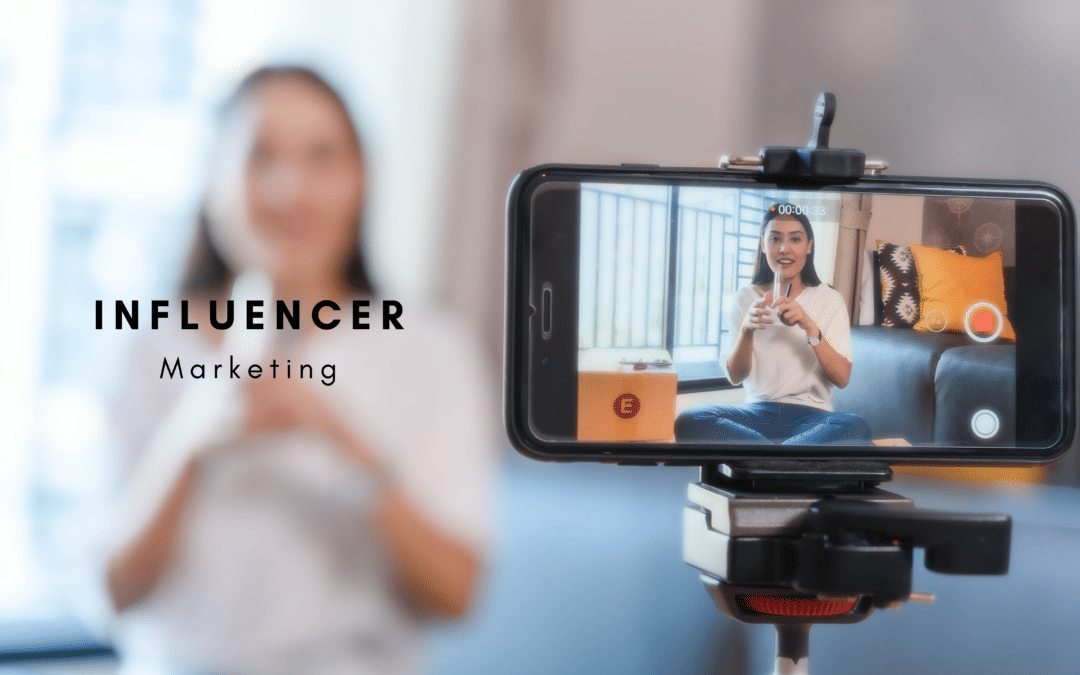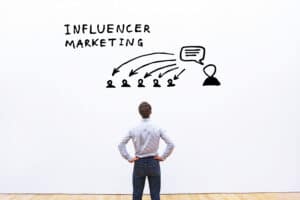Influencer marketing has been on the rise in the online marketing world and continues to gain traction. Yet there are people who still don’t fully understand what it means and how it could benefit your business. Let’s start with the basics.
What Are Influencers?
An influencer is someone who has expert knowledge on niche subjects and a strong social media influence. They usually have a large following and actively engage with their audience. This allows them to inspire others on purchasing decisions and help with brand awareness. Since influencers build a reputation for their expertise on certain topics, they can make a fantastic addition to your social media strategy.
According to Backlinko,“4.48 billion people currently use social media worldwide, up more than double from 2.07 billion in 2015.” This number is expected to grow, so it’s important your business puts in the extra effort to make sure your social media posts are able to reach a larger audience. This is where influencer marketing can be extremely helpful.
What Is Influencer Marketing?
Influencer marketing is the process of collaborating with influencers to endorse your brand and increase engagement on your social media.
An excellent example of successful influencer marketing was done by Dunkin’ Donuts. Their goal was to raise awareness of National Donut Day. To do so, they decided to collaborate with eight well-known influencers. Over the span of 24 hours, these eight influencers were given access to Dunkin’ Donuts’ SnapChat to create content about National Donut Day. Influencer Marketing Hub says: “The result was that Dunkin’ Donuts gained ten times more followers to their SnapChat channel on National Donut Day than they usually did in a month. The campaign reached 3 million people, with 40,000 cases of engagement.”
As you can see, influencer marketing has the potential to have a huge impact on your brand. Influencers are a popular resource on social media, and they gain more followers every day. They build up a large amount of trust with their followers, which can really boost your brand when they recommend your products. This is why influencer marketing works.
Types Of Influencers
There are four types of influencers. We will cover the differences between each type and which one would fit best with your marketing campaign or social media strategy. We will also share how to find and connect with them.
- Nano Influencer
Nano influencers have around 1K – 10K followers on their social media channels. They are experts in an obscure field. Most nano influencers have a very engaged following as they’re able to take the time to cultivate authentic relationships with their followers. Because they have a smaller following, it’s easier for them to keep track of responding to people. This makes them an excellent choice for a small to mid-size business, especially since they tend to be more cost-effective than those with a larger following. In fact, some nano influencers don’t charge at all because they’re attempting to build up their following.
The best place to research and find nano influencers is on Instagram. This is where influencers usually start their social media passion. One of the best ways to find them is by searching for hashtags related to your business. We’ve gone over everything you need to know about hashtags earlier this year, but let’s go over the basics of searching for your perfect influencer match.
Using the search bar in any social media platform, type in a hashtag relevant to your business, products or mission. From there, you can view posts people have made, how many followers they have and observe the quality of their posts.
With nano influencers, you can better personalize your marketing campaigns with a lower cost and an authentic voice for your brand awareness.
- Micro Influencer
Micro influencers usually have between 10K – 100K followers. Even with their larger following compared to nano influencers, micro influencers still tend to have a strong relationship with a targeted audience through authentic posts. Because they haven’t reached a huge number of followers yet, they still have that human connection that gets harder to cultivate as the following grows.
Companies looking to target a more particular audience should consider using micro influencers for their social media strategy since they specialize in a more specific niche. As they typically have a small amount of brand experience, micro influencers will be higher priced than nano influencers, but are still more affordable than a higher level of influencer. Micro influencers are also perfect for brands that are looking to raise a quick awareness of a specific product to a large, focused audience.
Finding micro influencers is very similar to finding nano influencers. Searching through hashtags is one of the best ways to do your research to boost your brand. It’s best to get even more specific on your search for micro influencers since they usually are already well-versed in specific specialties. They may even already be a fan of your brand!
- Macro Influencer
Macro influencers have from 100K – 1M followers and are usually content creators who have become internet famous. With their much larger following, engagement rates tend to go down at this level. They have a broader range of subjects to endorse and can use their reputation to gain more followers. This level also tends to have more professional-looking content that could be a better fit for certain brands.
Because macro influencers are usually well-known vloggers, bloggers, podcasters and more, the price tag gets higher at this level. They work best with companies that have a large budget and want a wider spread of brand awareness with quicker results compared to the lower levels.
Since macro influencers are content creators, it’s best to research them over multiple social media platforms. As with the other influencers, search for hashtags that are relevant to your brand and your industry and look for someone who best matches your brand’s business goals.
- Mega Influencers
With over one million followers, mega influencers reach the largest number of people with the highest price tag. They are typically celebrities and have a huge online presence. Because they generate a lot of followers and engagement, they are able to boost brand awareness more quickly than the others. If you have a large budget for your social media strategy, mega influencers could work for you. Their endorsements will get the biggest reach for your products.
Since mega influencers are well-known public figures, they are usually not very hard to find. Instead of searching with hashtags like the lower-level influencers, it’s best to search by name or find verified mega influencer accounts to see who would best work with your brand.
Influencer Marketing Strategy
Now that we’ve gone over the different types of influencers, it’s important to know how to create an influencer marketing strategy.
Your first step should be to decide what your marketing goals are and to set a budget. Think about who you want to reach and what deals or products you want to get out there. Maybe you’re looking to reach a younger customer base. Perhaps you want your product seen by a new group of customers you haven’t targeted before. Whatever your goals and budget end up being, make sure they’re clear so that it’s easier to find an influencer who you can afford and one that matches your goals – which brings us to the next step.
As stated earlier, it’s usually best to find influencers through hashtags. It would also be beneficial to start with one social media platform your business would like to focus on. Start looking for the type of influencer who fits your budget and goals. Hootsuite gives excellent advice by saying: “When thinking about who you want to work with, the key is trust. Your audience must trust and respect the opinions of the influencers you partner with. Without the trust component, any results will be superficial. You’ll struggle to see a tangible business impact from your efforts.”
Once you’ve found a few viable options, it’s time to reach out. Approaching influencers varies for each type, but one thing remains consistent throughout: before introducing yourself get to know them first. Research their profile and get to know their content and what type of audience they bring in. This will help you to communicate with them about why you think it would be a successful partnership. When you’re ready to contact them, keep it short and simple. Make your social media goals obvious and your compensation clear. Many influencers have a lot of businesses reaching out to them, so it would be smart to follow-up if there is no reply. Be respectful in your response, and if they don’t get back to you it’s time to start the search again.
The last piece of your influencer marketing strategy is to continue to review it. Even if you have an ongoing campaign, it’s beneficial to make sure your goals are being met and to know when it may be time to change things up.
Measuring Results
Measuring the results of your influencer marketing campaign is essential for growing your brand. There are many different ways to measure your success. Here’s a list of how to track your results:
- Post Engagement
Looking at how your audience interacts with your posts is a great way to see how well your campaign is going.
Monitor how many likes and shares your posts receive and keep track of your audience growth. Higher engagement means you are reaching more people.
- Website Traffic
One of the many benefits of having an influencer on your marketing campaign is that they can refer their followers to your website. Google Analytics is a terrific complementary source that helps you monitor the analytics and data of your site. You can easily measure the success of your campaign by keeping track of:
- The number of visitors your website gets
- The location of the traffic
- How they found your website
- The amount of time spent on your website
Monitoring your website traffic is a very reliable indicator of how well your campaign is doing.
- Discount Codes
Discount codes or promo codes are a way to share discounted products through a unique URL for social media. They are easy to set up and add to social media content. They can also be a great incentive for engaging your influencers and potential customers. Tracking how many products were purchased using the discount code provides you with another way to gauge your success.
Influencer marketing is here to stay. Finding the right influencer for your business, creating an influencer marketing strategy and measuring your results often can help your business thrive. Influencers help provide a different point of view on your products. They each create their own, distinctive content that could be the extra boost needed for your brand awareness.
Do You Need Help With Your Marketing Strategy?
Our team of experienced marketing and PR specialists can help! We offer a complimentary 30-minute, no-obligation consultation with our CEO Erika Taylor Montgomery! Contact us to learn more about how we can help you achieve your business goals.
Special Offer:
Sign up for a complimentary consultation during December and receive an Annual Marketing Planning Guide valued at $475! We offer a 30-minute phone consultation with our CEO, and can answer your questions and discuss your specific marketing needs - no strings attached. Call 408-218-2391 or contact us today to arrange your consultation!




